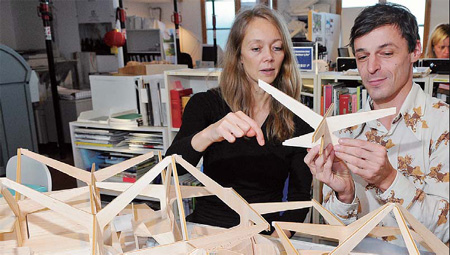For Reinhard Kropf and Siv Helene Stangeland, the Norwegian couple who designed this year's $22.8-million (156 million yuan) Norway pavilion, nature holds the key to a better life.
|
 Reinhard Kropf (right) and Siv Helene Stangeland work together on a model of the Norway pavilion. [Courtesy photo]
Reinhard Kropf (right) and Siv Helene Stangeland work together on a model of the Norway pavilion. [Courtesy photo] |
Their pavilion will be constructed from Chinese bamboo and 15 pine trees shipped from Norway in an attempt to show how easy it is to fuse the two cultures.
Wood is widely used as a construction material for residential properties in Norway while bamboo scaffolding can be found plastering the city of Shanghai.
"In the pavilion, we would like to present what Norway can contribute in terms of making a city better to live in," said the wife Stangeland, adding that cities cut ties with the natural world at their own expense.
"We want to bring nature into the city. This is what we seek to present in the pavilion."
The idea echoes the "Better city, Better life" theme of the Shanghai Expo.
"I think the real challenge in architecture is how to combine natural resources with new technology and new needs of society," Kropf said.
The model trees inside, which act like pillars, will be covered by a semi-transparent roof to create the effect of walking under a blue sky when the sun shines, he added.
The pavilion will also harness the sun's energy and have a water purification system in place.
It is the only wooden structure being built at the Shanghai Expo, and even this almost never materialized due to safety concerns (wood being so flammable). The couple resolved this problem by engineering a system whereby any fires would be channeled as safely as possible through the "trees" inside to give visitors enough time to escape in the event of a blaze.
Kropf said he is also brainstorming ideas to sustain the pavilion after the six-month expo period, when most of the structures will be torn down.
The pavilion is being built in such a way that it can be easily deconstructed after the expo and turned into an outdoor cinema, library or canteen, said Kropf.
Many companies and organizations in Shanghai and other provinces have registered interest in receiving one of the trees after the curtain falls in October.
Kropf and Stangeland have won numerous awards at their Stavanger studio on Norway's east coast, including the Annual National Award for Good Building and Environmental Design in 2009 for a hotel on Preikestolen Mountain.
The couple fell in love during their studies at the Oslo school of Architecture and Design and founded the Helen & Hard design company in 1996 after they graduated.
Their expo project has made the couple famous in Norway. Now they hope to introduce more "natural architecture" to China, they said.

